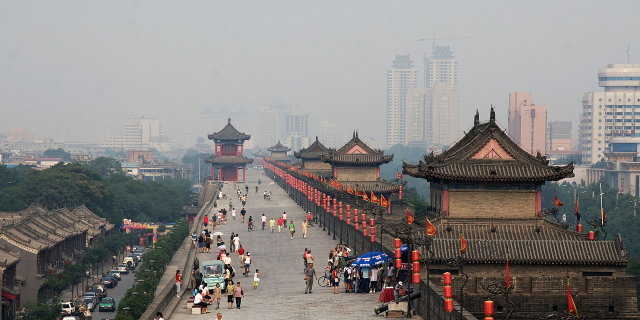The Wudang Mountains (simplified Chinese: 武当山; traditional Chinese: 武當山; pinyin: Wǔdāng Shān) are a mountain range in the northwestern part of Hubei, China. They are home to a famous complex of Taoist temples and monasteries associated with the Lord of the North, Xuantian Shangdi. The Wudang Mountains are renowned for the practice of tai chi and Taoism as the Taoist counterpart to the Shaolin Monastery, which is affiliated with Chan Buddhism. The Wudang Mountains are one of the "Four Sacred Mountains of Taoism" in China, an important destination for Taoist pilgrimages. The monasteries such as the Wudang Garden were made a UNESCO World Heritage Site in 1994 because of their religious significance and architectural achievement.
For centuries, the mountains of Wudang have been known as an important center of Taoism, especially famous for its Taoist versions of martial arts or tai chi.[1]
The first site of worship—the Five Dragons Temple—was constructed at the behest of Emperor Taizong of Tang.[2] Further structures were added during the Song and Yuan dynasties, while the largest complex on the mountain was built during the Ming dynasty (14th–17th centuries) as the Yongle Emperor claimed to enjoy the protection of the god Beidi or Xuantian Shangdi.[2] During the Ming Dynasty, 9 palaces, 9 monasteries, 36 nunneries and 72 temples were located at the site.[2] Temples regularly had to be rebuilt, and not all survived; the oldest existing structures are the Golden Hall and the Ancient Bronze Shrine, made in 1307.[2] Other noted structures include Nanyang Palace (built in 1285–1310 and extended in 1312), the stone-walled Forbidden City of the Taihe Palace at the peak (built in 1419), and the Purple Cloud Temple (built in 1119–1126, rebuilt in 1413 and extended in 1803–1820).[2][3] Today, 53 ancient buildings still survive. [2]
On January 19, 2003, the 600-year-old Yuzhengong Palace at the Wudang Mountains burned down after accidentally being set on fire by an employee of a martial arts school.[4] A fire broke out in the hall, reducing the three rooms that covered 200 square meters to ashes. A gold-plated statue of Zhang Sanfeng, which was usually housed in Yuzhengong, was moved to another building just before the fire, and so escaped destruction in the inferno.[1]



































Add new comment